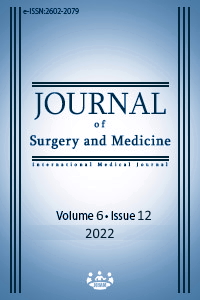The relationship between initial lactate levels and outcomes in patients diagnosed with diabetic ketoacidosis in the emergency department
Initial lactate levels and outcomes in patients with diabetic ketoacidosis
Keywords:
Diabetic ketoacidosis, Lactate, MortalityAbstract
Background/Aim: Diabetic ketoacidosis (DKA) is an endocrinological emergency frequently seen in emergency departments (ED). It can result in mortality if not treated appropriately. The aim of this study was to examine the relationship between baseline lactate levels and patient outcomes in DKA patients admitted to the emergency department (ED).
Methods: This retrospective cohort study was carried out in the ED of a tertiary hospital between May 2022 and November 2022 using the data of patients diagnosed with DKA. Patients with missing data, patients transferred from another hospital, patients with a diagnosis other than DKA, and patients who could not be followed up were excluded from the study. The primary outcome of the study was admission to the intensive care unit (ICU) and/or in-hospital mortality. The area under the curve (AUC) was calculated by receiver operating characteristic (ROC) regression analyses to predict critically ill patients with lactate levels.
Results: The study was completed with 95 patients. The mean age of the patients was 53.1 years and n = 46 were female. Twenty (21.1%) of these patients were admitted to the intensive care unit and 22 (23.2%) died. The statistical analysis showed that lactate levels were statistically significant in predicting critically ill patients (P < 0.001). ROC analysis showed that a lactate level of 2.6 mmol/dL could predict critically ill patients. The area under the curve was 0.823 (95% confidence interval: 0.731-0.894, sensitivity: 71.4, Specificity: 69.8), the Youden index was 0.476, and the P-value was 0.001.
Conclusion: According to the results of this study, there is a significant relationship between the initial lactate levels in DKA patients and patients who will require critical care. Therefore, lactate can be used as an appropriate follow-up tool in the management of DKA patients.
Downloads
References
Masharani U, Strycker LA, Lazar AA, Wu K, Brooks GA. Hyperlactatemia in diabetic ketoacidosis. Diabet Med. 2022 Apr;39(4):e14723. doi: 10.1111/dme.14723. DOI: https://doi.org/10.1111/dme.14723
Telci Çaklılı Ö, Gürbüz H. SARS-CoV-2 and community-acquired pneumonia leading to euglycemic diabetic ketoacidosis in two patients with type-1 diabetes mellitus who were not using SGLT2 inhibitors. J Surg Med. 2022;6(4):519-20. DOI: https://doi.org/10.28982/josam.979687
Control CfD, Prevention. National diabetes fact sheet: general information and national estimates on diabetes in the United States, 2007. Atlanta, GA: US Department of Health and Human Services, Centers for Disease Control and Prevention. 2008;1.
Corwell B, Knight B, Olivieri L, Willis GC. Current diagnosis and treatment of hyperglycemic emergencies. Emerg Med Clin North Am. 2014 May;32(2):437-52. doi: 10.1016/j.emc.2014.01.004. DOI: https://doi.org/10.1016/j.emc.2014.01.004
Kitabchi AE, Umpierrez GE, Miles JM, Fisher JN. Hyperglycemic crises in adult patients with diabetes. Diabetes Care. 2009 Jul;32(7):1335-43. doi: 10.2337/dc09-9032. DOI: https://doi.org/10.2337/dc09-9032
Hökenek, NM, Ak R. Prognostic value of blood gas lactate levels among COVID-19 patients. J Clin Med Kaz, 2021 Aug;18(4):87-90. DOI: https://doi.org/10.23950/jcmk/11130
Vincent JL, Quintairos E Silva A, Couto L Jr, Taccone FS. The value of blood lactate kinetics in critically ill patients: a systematic review. Crit Care. 2016 Aug 13;20(1):257. doi: 10.1186/s13054-016-1403-5. DOI: https://doi.org/10.1186/s13054-016-1403-5
Nguyen HB. Lactate in the critically ill patients: an outcome marker with the times. Crit Care. 2011;15(6):1016. doi: 10.1186/cc10531. DOI: https://doi.org/10.1186/cc10531
Suwarto S, Sutrisna B, Waspadji S, Pohan HT. Predictors of five days mortality in diabetic ketoacidosis patients: a prospective cohort study. Acta Med Indones. 2014 Jan;46(1):18-23.
Castellanos L, Tuffaha M, Koren D, Levitsky LL. Management of Diabetic Ketoacidosis in Children and Adolescents with Type 1 Diabetes Mellitus. Paediatr Drugs. 2020 Aug;22(4):357-67. doi: 10.1007/s40272-020-00397-0. DOI: https://doi.org/10.1007/s40272-020-00397-0
Eledrisi MS, Elzouki AN. Management of Diabetic Ketoacidosis in Adults: A Narrative Review. Saudi J Med Med Sci. 2020 Sep-Dec;8(3):165-73. doi: 10.4103/sjmms.sjmms_478_19. DOI: https://doi.org/10.4103/sjmms.sjmms_478_19
Sakal C, Ak R, Taşçı A, Kırkpantur ED, Ünal Akoğlu E, Cimilli Ozturk T. Admission blood lactate levels of patients diagnosed with cerebrovascular disease effects on short- and long-term mortality risk. Int J Clin Pract. 2021 Aug;75(8):e14161. doi: 10.1111/ijcp.14161. DOI: https://doi.org/10.1111/ijcp.14161
Masyuk M, Wernly B, Lichtenauer M, Franz M, Kabisch B, Muessig JM, et al. Prognostic relevance of serum lactate kinetics in critically ill patients. Intensive Care Med. 2019 Jan;45(1):55-61. doi: 10.1007/s00134-018-5475-3. DOI: https://doi.org/10.1007/s00134-018-5475-3
Doganay F, Ak R, Yilmaz E. Predictive Performance of Lactate as a Mortality Predictor in Patients with Acute Pancreatitis. J Coll Physicians Surg Pak. 2022 Apr;32(4):440-4. doi: 10.29271/jcpsp.2022.04.440. DOI: https://doi.org/10.29271/jcpsp.2022.04.440
Bauer M, Gerlach H, Vogelmann T, Preissing F, Stiefel J, Adam D. Mortality in sepsis and septic shock in Europe, North America and Australia between 2009 and 2019- results from a systematic review and meta-analysis. Crit Care. 2020 May 19;24(1):239. doi: 10.1186/s13054-020-02950-2. DOI: https://doi.org/10.1186/s13054-020-02950-2
Toffaletti JG. Blood lactate: biochemistry, laboratory methods, and clinical interpretation. Crit Rev Clin Lab Sci. 1991;28(4):253-68. doi: 10.3109/10408369109106865. DOI: https://doi.org/10.3109/10408369109106865
Taşkın G, Yılmaz M, Yılmaz S, Şirin H, Sapmaz H, Taşlıgil S, et al. Lactate kinetics in intensive care unit admissions due to diabetic ketoacidosis. Gulhane Med J. 2021;63(3):212-7. DOI: https://doi.org/10.4274/gulhane.galenos.2021.29290
Cetin M, Kilic TY, Yesilaras M, Uz I. Clinical utiliy of serum lactate levels in diabetic ketoacidosis in adult patients admitted to emergency department. Annals Med Res. 2022 Aug;29(8):827-30. DOI: https://doi.org/10.5455/annalsmedres.2022.02.065
Downloads
- 417 695
Published
Issue
Section
How to Cite
License
Copyright (c) 2022 Halil Alışkan, Mazlum Kılıç
This work is licensed under a Creative Commons Attribution-NonCommercial-NoDerivatives 4.0 International License.
















